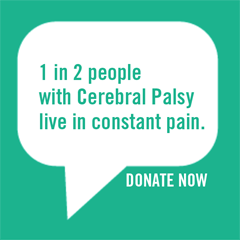
Phone: 212 520 1686
Email: info@yourcpf.org
SIGNS AND SYMPTOMS

The signs of cerebral palsy usually appear in the early months of life, although specific diagnosis may be delayed until age two or later. Infants with CP frequently have developmental delays, in which they are slow to reach developmental milestones such as learning to roll over, sit, crawl, or walk.
-
EVIDENCE IN DELAYED MOTOR SKILLS IN THE FIRST 12-18 MONTHS
IN A BABY YOUNGER THAN 6 MONTHS OF AGE
- THE HEAD DROOPS WHEN YOU PICK THEM UP WHILE THEY’RE LYING ON THEIR BACK
- THEY FEEL STIFF
- THEY FEEL FLOPPY
- WHEN YOU PICK THEM UP, THEIR LEGS GET STIFF AND CAN CROSS OR SCISSOR
-
IN A BABY OLDER THAN 6 MONTHS OF AGE
- THEY DON’T ROLL OVER IN EITHER DIRECTION
- THEY CAN’T BRING THEIR HANDS TOGETHER
- THEY HAVE DIFFICULTY BRINGING THEIR HANDS TO THEIR MOUTH
- THEY REACH OUT WITH ONLY ONE HAND WHILE KEEPING THE OTHER FISTED
-
IN A BABY OLDER THAN 10 MONTHS OF AGE
- THEY CRAWL IN A LOPSIDED MANNER, PUSHING OFF WITH ONE HAND AND LEG WHILE DRAGGING THE OPPOSITE HAND AND LEG
- THEY CANNOT STAND WITHOUT HOLDING ONTO SUPPORT
Some infants with CP have abnormal muscle tone. Decreased muscle tone (hypotonia) can make them appear relaxed, or even floppy. Increased muscle tone (hypertonia) can make them seem stiff or rigid.
The symptoms of CP differ in type and severity from one person to the next, and may even change in an individual over time. All people with CP have problems with movement and posture, and some also have a certain level of intellectual disability. Seizures, abnormal physical sensations or perceptions, and other medical disorders are common in individuals with CP. People with CP may also have impaired vision or hearing, and communication issues.
CHILDREN WITH CP EXHIBIT A WIDE VARIETY OF SYMPTOMS,* INCLUDING:
- lack of muscle coordination when performing voluntary movements (ataxia);
- stiff or tight muscles and exaggerated reflexes (spasticity);
- weakness in one or more arm or leg;
- walking on the toes, a crouched gait, or a “scissored” gait;
- variations in muscle tone, either too stiff or too floppy;
- excessive drooling or difficulties swallowing or speaking;
- shaking (tremor) or random involuntary movements;
- delays in reaching motor skill milestones;
- difficulty with precise movements such as writing or buttoning a shirt.
* It is important to note that some children without CP also may show some of these signs.







